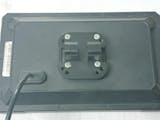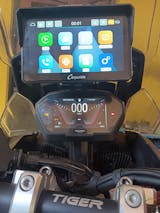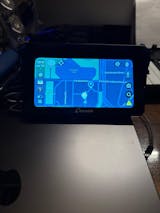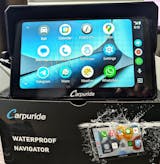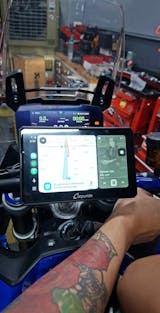Motorcycles, as one of popular transportation, have been in development for many years. However, they often lack entertainment devices like radios when they leave the factory. In recent decades, with technological advancements and changing consumer demands, high-end motorcycles have started to come equipped with radios, while most ordinary motorcycles still do not. So many riders choose to install radios themselves to listen to music and obtain traffic information during long trips. Therefore, whether a motorcycle has a radio largely depends on the rider's personal choice and needs.
Installing a radio for motorcycle is not a difficult task, but it involves several issues that riders are interested in. This article will explore a few key questions: What types of radios are available for motorcycles? Is it safe to listen to the radio while riding? And is this practice legal? Through this article, Carpuride hopes to provide practical information and advice to motorcycle enthusiasts.
The Development of Motorcycle Radios
Early Development
Motorcycles date back to the mid-20th century when they were primarily seen as practical transportation tools, focusing mainly on performance and durability. During that period, it was extremely rare for motorcycles to be equipped with radios. The limited installation space and the challenges of using such equipment in various weather conditions made it difficult for these entertainment devices to become widespread. Only a very few high-end custom motorcycles considered adding radios.
Technological Advancements
With the development of electronic technology from the late 20th century to the early 21st century, smaller and more durable motorcycle radios began to emerge. These radios could withstand the vibrations and harsh conditions encountered while riding. During this period, radios and other digital media playback devices started to be more widely integrated into motorcycles, especially in the mid to high-end market, becoming either standard or optional features.
Rising Demand for Radios
Changing Rider Needs
As long-distance travel and motorcycle touring became increasingly popular, increased people started riding motorcycles, and many riders began seeking a richer riding experience. Riders not only needed more navigation information during their journeys but also wanted to enjoy music or radio programs to enhance the pleasure and comfort of their trips. Consequently, the demand for radios and other entertainment systems naturally increased.
Limitations of Motorcycle Radios
Despite the introduction of radios and other streaming devices on motorcycles, many of the early radio systems were not well-designed and had several limitations. For example, the sound quality might be poor, unable to provide clear audio output in noisy environments, or the operation might be complex, making it inconvenient to use while riding.
These issues led riders to seek not just any motorcycle radio but a better-integrated solution for audio control and entertainment.
Types of Motorcycle Radios Available
In-Helmet Speakers
Helmet speaker systems are audio devices integrated directly into motorcycle helmets. They can be earphones too. These typically connect to a phone or other device via Bluetooth.
Advantages:
-
Maintains clear sound quality because the audio source is very close to the ears.
-
Keeps the motorcycle’s appearance clean without the need for additional external devices.
-
Convenient to use, as they are integrated into the helmet and do not distract the rider by requiring the operation of an audio system.
Disadvantages:
-
Long-term use may cause ear discomfort, especially in designs where the helmet fits tightly around the ears.
-
Volume control and device switching can be challenging, especially while riding, as these actions typically need to be performed through the connected device (such as a smartphone or motorcycle console).
Handlebar or Fairing-Mounted Speakers
These speakers are directly mounted on the motorcycle’s handlebar or fairing, making them easy to install and operate, while also allowing the rider to control the audio more easily. They typically connect to a phone or other device via Bluetooth.
Advantages:
-
Easy to install and operate, with many designs allowing the rider to adjust the volume and select channels directly while riding.
-
Provides a good audio experience, especially at lower speeds, as the speakers face the rider.
Disadvantages:
-
At high speeds or in noisy environments, external noise can significantly impact sound quality.
-
Externally mounted speakers are more susceptible to damage from weather conditions and road dust particles.
Built-In Speakers
Built-in speaker systems are designed to be fully integrated into the motorcycle’s dashboard or other internal structures, offering a more advanced but also more expensive radio solution.
Advantages:
-
Provides the best audio output quality, with design considerations for noise reduction and sound quality optimization.
-
Maintains a clean appearance without affecting the motorcycle’s exterior design and aerodynamics.
Disadvantages:
-
The installation process is complex and usually requires professional assistance, which can involve expensive installation fees.
-
Maintenance and upgrades can be more difficult because the components are typically hidden inside the motorcycle.

Carpuride W702 Motorcycle Stereo System
The above products encountered various issues during use—audio control difficulties, poor usability in different weather conditions, or subpar sound quality, among others. Carpuride integrates their advantages while addressing their shortcomings.
By connecting to your phone via Bluetooth, the Carpuride W702 motorcycle stereo system, when paired with in-helmet speakers or earphones, offers an excellent riding experience. All operations can be carried out through the W702's built-in CarPlay or Android Auto. It has the following advantages:

Enhanced Audio Quality
Uses helmet-integrated speakers or earphones for clear, high-quality audio.
User-Friendly Controls
All operations are managed through CarPlay or Android Auto for intuitive and easy use. And it can adjust brightness based on ambient light.
Weather Resilience
IP67 waterproof and dustproof rating for reliability in various weather conditions.
Safety
Can be installed and adjusted on handlebars to avoid vision obstruction.
Easy Installation and Removal
Quick installation in a few minutes and removal within a minute to prevent theft. You can install it on any motorcycle.Motorcycle Radio Safety Issues
Using motorcycle radios and audio systems can add convenience and entertainment to your riding, but they also come with some safety concerns. It’s important to be aware of these issues and take measures to mitigate them.
Distracted Riding
Operating audio equipment can distract riders and increase the risk of accidents. It is advised to choose those audio system that are easy to control, like those with voice commands or precise controls, such as the Carpuride W702. Try to adjust settings, like volume or channels, when you're parked and safe.
Hearing Damage
Prolonged use of headphones or high-volume audio systems in noisy environments can harm your hearing. You can use audio systems with noise control features, like in-helmet speakers with ambient noise reduction.
Delayed Reactions
The music volume from the radio might interfere with your ability to hear approaching vehicles or emergency alerts. Choose the radio system that you can quickly mute or adjust volume automatically. Keep the volume lower than the ambient noise level to ensure you can still hear important sounds around you.
Legal Concerns
In some places, using headphones or certain audio equipment while riding may not be legal.
Before installing and using any radio system, make sure to check and follow local laws and regulations to ensure you’re compliant and safe.
Conlusion
The advent of radios and other entertainment systems has made the motorcycle riding experience more enjoyable and comfortable. These radio systems have become more efficient and versatile, catering to the diverse needs and preferences of riders.
However, regardless of whether you choose to install a radio on your motorcycle, it's crucial to prioritize road safety. Minimize the distractions these radio systems may cause and be responsible for maintaining safety on the road.











